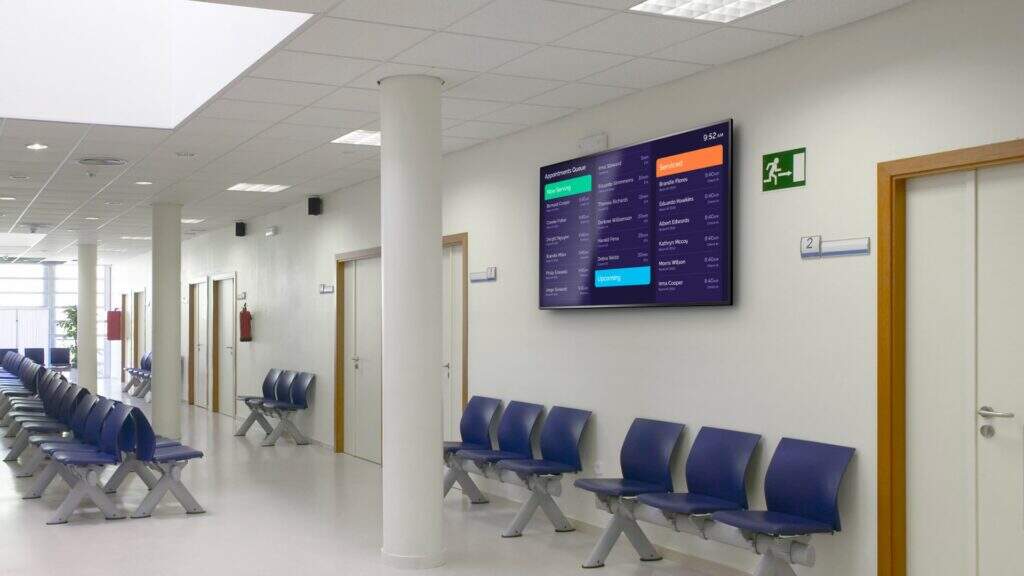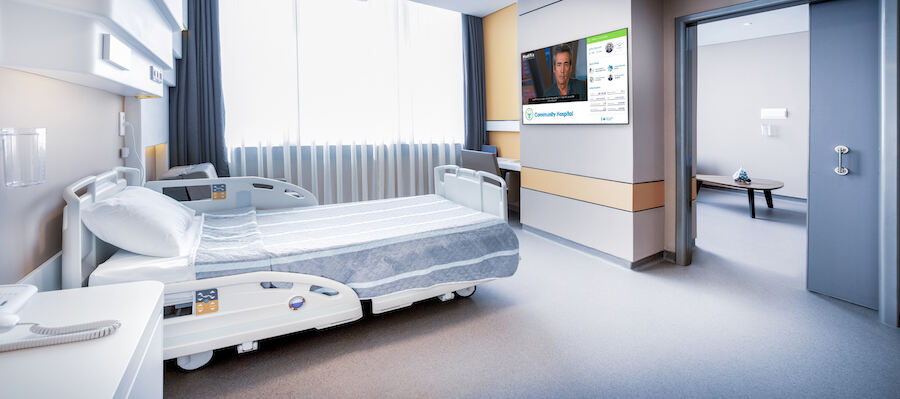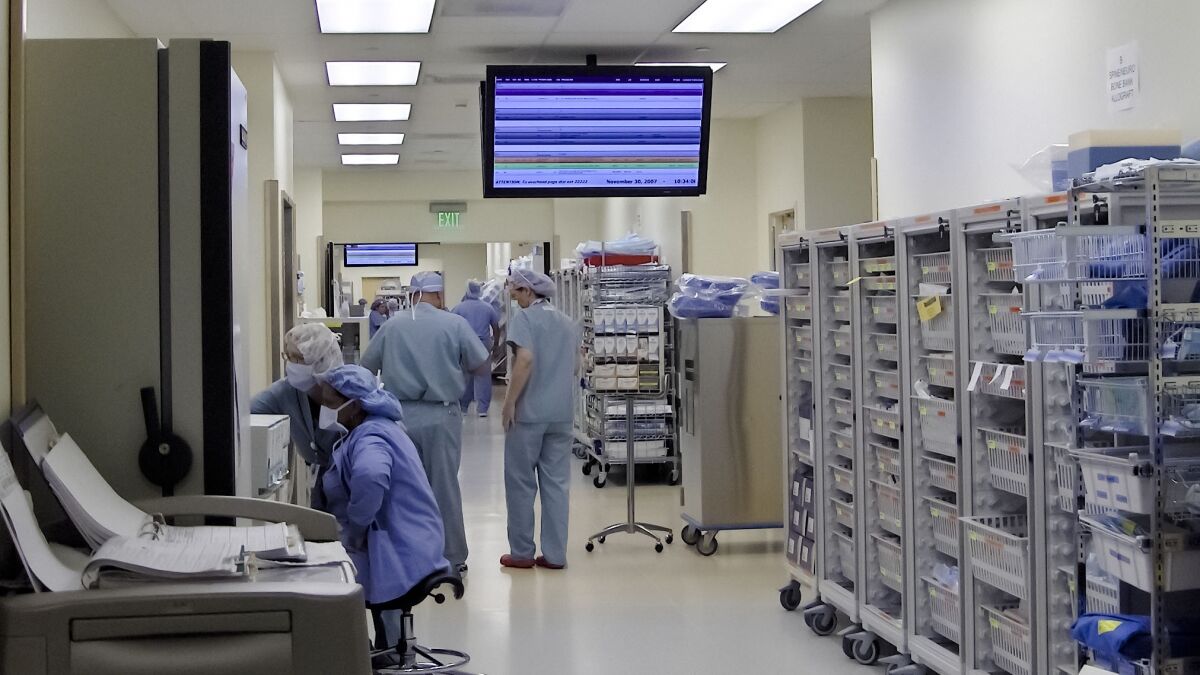Xu hướng Bảng hiệu Kỹ thuật số trong Chăm sóc sức khỏe 2025: Làm thế nào để Cải thiện Trải nghiệm của Bệnh nhân tại các Cơ sở Chăm sóc sức khỏe?

Với sự tiến bộ liên tục của công nghệ, ngành y tế đang tích hợp nhanh chóng các công cụ kỹ thuật số để nâng cao trải nghiệm bệnh nhân, tối ưu hóa quy trình làm việc và cải thiện hiệu quả dịch vụ. Trong số những đổi mới công nghệ này, biển báo kỹ thuật số y tế đã trở thành một thành phần quan trọng không thể bỏ qua. Cho dù ở sảnh của tòa nhà bệnh viện, trong khu vực điều trị hoặc trong phòng chờ, biển báo kỹ thuật số đang trở thành một yếu tố không thể thiếu trong môi trường y tế. Nó không chỉ là một công cụ hiển thị thông tin, mà còn là một cầu nối quan trọng kết nối các tổ chức y tế và bệnh nhân và cải thiện trải nghiệm bệnh nhân.
Vào năm 2025, với sự phát triển liên tục của trí tuệ nhân tạo (AI), Internet of Things (IoT) và công nghệ dữ liệu lớn, biển báo kỹ thuật số y tế sẽ mở ra những thay đổi mới, giúp các tổ chức y tế đạt được một mức độ mới về trải nghiệm bệnh nhân, cung cấp thông tin và hiệu quả hoạt động. Bài viết này sẽ tìm hiểu về xu hướng của biển báo kỹ thuật số y tế vào năm 2025 và làm thế nào nó có thể thúc đẩy đổi mới và tối ưu hóa các dịch vụ y tế bằng cách cải thiện trải nghiệm bệnh nhân.
Nếu bạn muốn biết thêm chi tiết, vui lòng liên hệ với tôi trên
WhatsApp: +86-13501581295
E-mail: [email protected]
Trang web là: https://www.uhopestar.com/
Truyền thông năng động thời gian thực: cải thiện tính minh bạch thông tin bệnh nhân
Ở các cơ sở y tế, bệnh nhân thường phải đối mặt với các quy trình điều trị y tế phức tạp và thời gian chờ đợi dài. Trong quá trình này, bệnh nhân thường cảm thấy lo lắng và không thoải mái. Hệ thống biển báo kỹ thuật số có thể giảm hiệu quả nghi ngờ và sự khó chịu của bệnh nhân và cải thiện trải nghiệm y tế của họ bằng cách cập nhật và hiển thị thông tin theo thời gian thực.
1. Cung cấp thông tin y tế và tình trạng xếp hàng thời gian thực
Bằng cách cài đặt biển báo kỹ thuật số trong khu vực chờ và phòng điều trị, các tổ chức y tế có thể hiển thị các hàng đợi của các phòng khác nhau, tình trạng tiếp nhận của bác sĩ và thời gian chờ dự kiến trong thời gian thực. Điều này không chỉ giúp bệnh nhân sắp xếp thời gian hợp lý mà còn làm giảm sự lo lắng do thời gian chờ đợi dài. Bệnh nhân có thể thấy vị trí xếp hàng hiện tại của họ trong khu vực chờ và khi nào họ dự kiến sẽ đến lượt, điều này cải thiện đáng kể tính minh bạch và sự hài lòng của bệnh nhân.
2. Đẩy nhắc khẩn cấp và thông báo sức khỏe
Biểu hiệu kỹ thuật số cũng có thể được sử dụng như một cách hiệu quả để phát hành thông báo khẩn cấp và lời nhắc sức khỏe. Ví dụ, khi xảy ra tai nạn y tế, khẩn cấp hoặc thông báo đình chỉ, biển báo kỹ thuật số có thể nhanh chóng truyền thông tin để đảm bảo rằng bệnh nhân được thông báo kịp thời và tránh rắc rối không cần thiết. Ngoài ra, nội dung giáo dục y tế công cộng như tiêm chủng, chế độ ăn uống lành mạnh, lời khuyên tập thể dục, v.v. cũng có thể được thúc đẩy để cải thiện nhận thức về sức khỏe của bệnh nhân.
Trải nghiệm tương tác: giúp bệnh nhân dễ dàng nhận thông tin cần thiết
Năm 2025, với sự phổ biến của các biển báo kỹ thuật số tương tác, biển báo kỹ thuật số y tế sẽ không chỉ giới hạn trong việc truyền thông một chiều. Bệnh nhân có thể tương tác với biển báo kỹ thuật số thông qua màn hình cảm ứng, nhận dạng giọng nói và các công nghệ khác để có được thông tin cá nhân và chính xác hơn.
1. Yêu cầu thông tin tùy chỉnh
Bệnh nhân có thể truy vấn vị trí của các phòng y tế có liên quan, nền tảng chuyên môn của bác sĩ, giờ khám và thông tin khác thông qua màn hình cảm ứng, và thậm chí có thể đặt cuộc hẹn trực tiếp. Bảng hiệu kỹ thuật số sử dụng giao diện tương tác để cho phép bệnh nhân nhanh chóng có được thông tin họ cần mà không phải dựa vào nhân viên tiếp tân bận rộn. Dịch vụ tự phục vụ này có thể giảm hiệu quả khối lượng công việc của các tổ chức y tế và tăng cường sự tự chủ và kinh nghiệm của bệnh nhân.
2. Hướng dẫn ảo: cải thiện cảm giác định hướng và tiện lợi
Các cơ sở y tế lớn thường có kiến trúc phức tạp, và bệnh nhân dễ bị lạc đường. Biểu hiệu kỹ thuật số có thể được kết hợp với các chức năng hướng dẫn ảo để cung cấp cho bệnh nhân các dịch vụ định vị thời gian thực. Thông qua màn hình cảm ứng, bệnh nhân có thể chọn điểm đến và nhận được hướng dẫn rõ ràng về tuyến đường. Điều này không chỉ cải thiện sự tiện lợi của bệnh nhân mà còn cải thiện trải nghiệm di chuyển của bệnh nhân trong bệnh viện.
Các khuyến nghị cá nhân: Các dịch vụ thông minh cải thiện trải nghiệm bệnh nhân
Với sự giúp đỡ của trí tuệ nhân tạo (AI) và phân tích dữ liệu lớn, biển báo kỹ thuật số có thể đưa ra các khuyến nghị nội dung cá nhân dựa trên thông tin lịch sử, sở thích nhu cầu và mô hình hành vi của bệnh nhân. Năm 2025, các bảng hiệu kỹ thuật số y tế sẽ thông minh hơn và có thể đáp ứng chính xác nhu cầu của các bệnh nhân khác nhau.
1. Đẩy thông tin sức khỏe cá nhân
Thông qua phân tích dữ liệu, biển báo kỹ thuật số có thể đưa thông tin sức khỏe cá nhân hóa đến bệnh nhân. Ví dụ, trong khi bệnh nhân đang chờ đợi, hệ thống có thể thúc đẩy kiến thức sức khỏe thích hợp hoặc đề xuất các xét nghiệm và kế hoạch điều trị có liên quan dựa trên hồ sơ y tế hoặc tình trạng sức khỏe của họ. Dịch vụ cá nhân này không chỉ có thể cải thiện sự hài lòng của bệnh nhân mà còn tăng cường niềm tin và lòng trung thành của bệnh nhân đối với bệnh viện.
2. Quảng cáo và thông tin quảng cáo cá nhân
Ngoài nội dung giáo dục sức khỏe, các tổ chức y tế cũng có thể sử dụng biển báo kỹ thuật số để đẩy quảng cáo hoặc thông tin quảng cáo cá nhân. Ví dụ, nếu bệnh nhân thường xuyên đến phòng nhãn khoa, biển báo kỹ thuật số có thể hiển thị thông tin giảm giá về gói kiểm tra sức khỏe nhãn khoa hoặc các sản phẩm liên quan. Việc tiếp thị chính xác này có thể làm tăng tỷ lệ chuyển đổi dịch vụ y tế và thúc đẩy tăng trưởng kinh doanh trong bệnh viện.

Chăm sóc cảm xúc: Hãy tạo ra một môi trường y tế ấm áp và thoải mái
Tình trạng tinh thần của bệnh nhân rất quan trọng trong quá trình điều trị. Một môi trường thoải mái và một bầu không khí tốt có thể làm giảm bớt sự lo lắng của bệnh nhân. Biểu tượng kỹ thuật số y tế không chỉ là một công cụ truyền thông, nó cũng có thể đóng một vai trò trong chăm sóc cảm xúc.
1. Chơi nhạc và video nhẹ nhàng
Trong khi bệnh nhân đang chờ đợi, bảng hiệu kỹ thuật số có thể phát một số nhạc thư giãn và êm dịu, video về cảnh quan thiên nhiên hoặc phim ngắn năng lượng tích cực để giúp bệnh nhân thư giãn và giảm căng thẳng khi tìm kiếm điều trị y tế. Thông qua sự tích hợp liền mạch với môi trường, biển báo kỹ thuật số sẽ cung cấp cho bệnh nhân trải nghiệm cảm xúc tốt hơn.
2. Báo cáo những câu chuyện bệnh nhân và thông tin ấm áp
Bệnh viện cũng có thể sử dụng biển báo kỹ thuật số để hiển thị câu chuyện hồi phục của bệnh nhân, video chăm sóc của nhân viên y tế và các hoạt động phúc lợi công cộng của bệnh viện. Những nội dung nhân văn như vậy không chỉ làm cho bệnh nhân cảm thấy ấm áp trong bệnh viện mà còn tăng cường mối liên hệ cảm xúc giữa bệnh nhân và các cơ sở y tế.
Cải thiện hiệu quả của các dịch vụ y tế: đơn giản hóa quy trình hoạt động
Một lợi thế lớn khác của biển báo kỹ thuật số là nó có thể cải thiện hiệu quả hoạt động của các tổ chức y tế, giảm trùng lặp công việc và cải thiện tính minh bạch của quy trình làm việc.
1. Đặt hàng tự động và phân loại
Với biển báo kỹ thuật số, các tổ chức y tế có thể tự động hóa quá trình xếp hàng và phân loại. Khi bệnh nhân đăng ký, hệ thống có thể tự động tạo ra thông tin xếp hàng và hiển thị nó trên bảng hiệu kỹ thuật số. Bệnh nhân có thể sắp xếp thời gian của họ một cách hợp lý theo tình trạng xếp hàng được hiển thị mà không phải thường xuyên hỏi nhân viên tiếp tân. Điều này không chỉ tiết kiệm thời gian của bệnh nhân mà còn cải thiện hiệu quả hoạt động của bệnh viện.
2. Quản lý hậu trường và phân tích dữ liệu
Biểu hiệu kỹ thuật số y tế cũng có thể nhận ra việc cập nhật tự động nội dung và thông tin quảng cáo thông qua hệ thống quản lý hậu trường. Thông qua phân tích dữ liệu, bệnh viện có thể hiểu phản ứng của bệnh nhân đối với nội dung quảng cáo khác nhau, do đó tối ưu hóa chiến lược phân phối quảng cáo và cải thiện hiệu quả tiếp thị. Ngoài ra, bệnh viện cũng có thể tối ưu hóa quy trình y tế dựa trên phân tích dữ liệu, giảm thời gian chờ đợi bệnh nhân và cải thiện hiệu quả tổng thể.

Biểu hiệu kỹ thuật số màn hình cảm ứng: Làm thế nào bệnh nhân có thể dễ dàng truy cập thông tin và hẹn hẹn?
Khi ngành y tế tiếp tục tiến về phía số hóa và trí thông minh, bảng hiệu kỹ thuật số màn hình cảm ứng, như một phương tiện kỹ thuật sáng tạo, đang được sử dụng rộng rãi trong bệnh viện và phòng khám. Những thiết bị thông minh này không chỉ cải thiện hiệu quả dịch vụ của bệnh viện mà còn cung cấp cho bệnh nhân trải nghiệm y tế thuận tiện và thoải mái hơn. Đặc biệt là về truy vấn thông tin và hẹn hẹn dịch vụ, biển báo kỹ thuật số màn hình cảm ứng có thể giảm hiệu quả thời gian chờ đợi của bệnh nhân và cải thiện chất lượng dịch vụ của bệnh viện.
1.Cung cấp truy vấn thông tin thời gian thực để giảm lo lắng của bệnh nhân
Ở bệnh viện, bệnh nhân thường phải đối mặt với các quy trình điều trị y tế phức tạp và thời gian chờ đợi rất lâu. Các phương pháp truy vấn thông tin truyền thống, chẳng hạn như xếp hàng để tham khảo và đọc thông báo trên giấy, không chỉ lãng phí thời gian mà còn dễ dàng dẫn đến lỗi hoặc sự chậm trễ thông tin. Biểu tượng kỹ thuật số màn hình cảm ứng cung cấp cho bệnh nhân thông tin ngay lập tức và chính xác thông qua khả năng cập nhật thời gian thực, giảm lo lắng của họ.
(1) Hiển thị thông tin chờ trong thời gian thực: Biểu hiệu kỹ thuật số màn hình cảm ứng có thể hiển thị tiến độ xếp hàng của bệnh nhân, thông tin cuộc gọi, thời gian chờ đợi, v.v. trong thời gian thực. Bệnh nhân có thể trực tiếp kiểm tra tình trạng sức khỏe của họ trên màn hình cảm ứng và hiểu thời gian dự kiến của cuộc tư vấn, tránh sự lo lắng khi chờ đợi lâu.
(2) Đặt câu hỏi về thông tin về phòng khám và bác sĩ: Có nhiều phòng khám trong bệnh viện và chúng được phân phối rộng rãi. Bệnh nhân đôi khi bị lạc vì họ không quen thuộc với môi trường bệnh viện. Thông qua màn hình cảm ứng, bệnh nhân có thể dễ dàng truy vấn vị trí của mỗi phòng khám và thông tin lịch trình của bác sĩ, giúp họ nhanh chóng tìm thấy phòng khám cần thiết và giảm lãng phí thời gian không cần thiết.
(3) Giáo dục và quảng cáo sức khỏe: Biểu tượng kỹ thuật số không chỉ cung cấp thông tin y tế cơ bản, mà còn phát video giáo dục sức khỏe, kiến thức khoa học phổ biến và thông báo bệnh viện và thông tin sự kiện. Trong khi chờ tham khảo ý kiến, bệnh nhân có thể tìm hiểu về các mẹo sức khỏe, tiêm chủng, phòng ngừa bệnh tật và các nội dung liên quan khác bất cứ lúc nào để nâng cao nhận thức về sức khỏe của họ.
#máytínhbảngdànhchochuyêngiachămsócsứckhỏe #microsoftsurfacehealthcare #máytínhbảngtheodõiykhoa #máytínhbảngykhoa #máytínhbảngchămsócsứckhỏe
2. Dịch vụ tự phục vụ hẹn giờ cải thiện hiệu quả điều trị y tế
Các phương pháp hẹn hẹn truyền thống thường yêu cầu bệnh nhân đặt hẹn qua điện thoại hoặc các nền tảng trực tuyến, và khi đặt hẹn tại chỗ tại bệnh viện, họ có thể phải xếp hàng. Điều này không chỉ làm lãng phí thời gian của bệnh nhân mà còn gây áp lực lớn cho nhân viên tiếp tân của bệnh viện. Chức năng tự phục vụ hẹn hẹn của bảng hiệu kỹ thuật số màn hình cảm ứng có thể cung cấp cho bệnh nhân các dịch vụ hẹn hẹn hiệu quả và thuận tiện hơn.
(1) Đặt hẹn nhanh: Bệnh nhân có thể trực tiếp vào hệ thống hẹn của bệnh viện thông qua màn hình cảm ứng, chọn phòng và bác sĩ phù hợp theo nhu cầu của họ, kiểm tra thời gian có sẵn và đặt hẹn nhanh chóng. Không cần phải gọi điện thoại hoặc xếp hàng tại chỗ, tiết kiệm rất nhiều thời gian và năng lượng.
(2) Xác nhận thông tin hẹn ngay lập tức: Sau khi hẹn hẹn thành công, bảng hiệu kỹ thuật số màn hình cảm ứng sẽ ngay lập tức hiển thị thông tin xác nhận hẹn, bao gồm thông tin chi tiết như phòng khám, bác sĩ và thời gian hẹn. Bệnh nhân có thể dễ dàng xem và điều chỉnh hoặc bổ sung theo hoàn cảnh cá nhân của họ.
(3) Chức năng nhắc nhở hẹn: Đối với bệnh nhân đã đặt hẹn, bảng hiệu kỹ thuật số có thể thiết lập chức năng nhắc nhở để nhắc nhở bệnh nhân về thời gian hẹn và phòng khám trước khi hẹn, giúp bệnh nhân chuẩn bị kịp thời và tránh bỏ lỡ thời gian hẹn.
#cơ quan y tếtabletpc #medicalpctablet #tabletpcmedical #androidmedicaltablet #besttabletformmedicaloffice #medicalofficetablet #besttabletforhealthcareproviders
3. Cải thiện trải nghiệm tương tác bệnh nhân và tạo điều kiện cho việc hỏi các dịch vụ khác
Các dịch vụ của bệnh viện không chỉ là về chính điều trị y tế, mà còn liên quan đến nhiều chức năng và dịch vụ khác, chẳng hạn như mua thuốc, xét nghiệm trong phòng thí nghiệm, thanh toán thanh toán, vv. Thông qua bảng hiệu kỹ thuật số màn hình cảm ứng, bệnh nhân có thể dễ dàng hỏi về các dịch vụ bổ sung này, cải
(1) Tìm hiểu thông tin về ma túy: Nhiều bệnh viện cung cấp dịch vụ tìm kiếm thông tin thuốc thông qua biển báo kỹ thuật số màn hình cảm ứng. Bệnh nhân có thể nhập tên thuốc hoặc bộ phận để hỏi về thông tin liên quan của các loại thuốc cần thiết, bao gồm giá cả, sử dụng và hàng tồn kho của các loại thuốc. Chức năng này tạo điều kiện giao tiếp giữa bệnh nhân và hiệu thuốc trong quá trình điều trị y tế và cải thiện hiệu quả mua hàng.
(2) Đặt và điều tra xét nghiệm trong phòng thí nghiệm: Khi bệnh nhân được kiểm tra hoặc xét nghiệm, họ thường phải chờ lâu để hoàn thành chúng. Thông qua màn hình cảm ứng, bệnh nhân có thể hẹn khám, xem kết quả xét nghiệm và thậm chí trực tiếp đến phòng khám có liên quan để hoàn thành kiểm tra theo hướng dẫn của bệnh viện, tránh xếp hàng nhiều lần.
(3) Thanh toán và thanh toán: Một số bệnh viện cũng đã tích hợp các chức năng thanh toán vào hệ thống biển báo kỹ thuật số. Bệnh nhân có thể sử dụng màn hình cảm ứng để thanh toán ngay cho phí đăng ký, phí kiểm tra và phí thuốc, giảm thời gian xếp hàng tại quầy tiếp tân và làm cho quá trình y tế suôn sẻ hơn.
#máytínhbảngđiềukiệntốtnhấtchochuyêngiaykhoa #máytínhbảngđiềukiệnytếkhôngcầnquạt #máytínhbảngđiềukiệntốtnhấtchobệnhviện #máytínhbảngđiềukiệnchobệnhviện #máytínhbảngđiềukiệnchobệnhviện #máytínhbảngchămsócsứckhỏe #máytínhbảngđiềukiệnandroidykhoa
4. Hỗ trợ đa ngôn ngữ, loại bỏ rào cản ngôn ngữ
Ở các thành phố có mức độ quốc tế hóa cao, bệnh nhân bệnh viện thường đến từ các quốc gia và khu vực khác nhau. Rào cản ngôn ngữ thường khiến bệnh nhân không phải là người bản địa cảm thấy khó chịu trong quá trình điều trị y tế và thậm chí có thể ảnh hưởng đến chất lượng điều trị y tế do truyền thông kém. Chức năng hỗ trợ đa ngôn ngữ của bảng hiệu kỹ thuật số màn hình cảm ứng loại bỏ hiệu quả rào cản này. #bestmedicaltabletpc
(1) Chọn nhiều ngôn ngữ: Biểu tượng kỹ thuật số màn hình cảm ứng hỗ trợ chuyển đổi nhiều ngôn ngữ và bệnh nhân có thể chọn giao diện ngôn ngữ phù hợp để hoạt động theo nhu cầu ngôn ngữ của họ. Cho dù là bệnh nhân địa phương hay bệnh nhân nước ngoài, họ có thể dễ dàng truy vấn thông tin cần thiết thông qua các hoạt động đơn giản.
(2) Dịch vụ quốc tế: Để đáp ứng nhu cầu của bệnh nhân có nền văn hóa khác nhau, biển báo kỹ thuật số cũng có thể điều chỉnh phương pháp hiển thị nội dung theo thói quen của các ngôn ngữ khác nhau, để bệnh nhân có thể nhận được các dịch vụ cá nhân hơn.
#medicalpc #medicalcomputer #tablethospital #tabletpcmanufacturers #pctabletmedicine #medicaltabletpc #proscribmedicaltabletpc #bestandroidtabletform medicalstudents #các nhà sản xuất máy tính bảng #các nhà sản xuất máy tính bảng #các
Biểu tượng kỹ thuật số màn hình cảm ứng không chỉ cải thiện tính minh bạch của thông tin bệnh viện và khả năng tự phục vụ của bệnh nhân, mà còn giúp bệnh viện và phòng khám cải thiện hiệu quả hoạt động và giảm căng thẳng của nhân viên bằng cách đơn giản hóa quy trình y tế, cải thiện trải nghiệm bệnh nhân và cung cấp nhiều dịch vụ thuận tiện Trong làn sóng chăm sóc sức khỏe kỹ thuật số, ngày càng có nhiều bệnh viện và phòng khám nhận thức được tầm quan trọng của biển báo kỹ thuật số và đang tích cực giới thiệu công cụ sáng tạo này. Kết quả là, bệnh nhân có thể tận hưởng các dịch vụ y tế thuận tiện, thoải mái và hiệu quả hơn.

#tablet giám sát y tế #icumonitor #tablet y tế máy tính # chăm sóc đặc biệt #tablet android11 #hospitaltablet #healthcaretablet #healthcaretablets
Kết luận: Biểu hiệu kỹ thuật số y tế vào năm 2025, tương lai hứa hẹn
Năm 2025, biển báo kỹ thuật số y tế không chỉ là một công cụ hiển thị thông tin đơn giản, nó đã dần trở thành một phần quan trọng của các tổ chức y tế để cải thiện trải nghiệm bệnh nhân, tối ưu hóa hiệu quả hoạt động và nâng cao hình ảnh thương hiệu. Với sự phát triển liên tục của các công nghệ như AI, Internet of Things và dữ liệu lớn, biển báo kỹ thuật số y tế sẽ trở nên thông minh hơn và cá nhân hóa hơn, giúp các tổ chức y tế đạt được các dịch vụ hiệu quả hơn, ấm áp và sáng tạo hơn.
Đối với các tổ chức y tế, đầu tư vào hệ thống biển báo kỹ thuật số y tế không chỉ là một phương tiện hiệu quả để cải thiện trải nghiệm bệnh nhân, mà còn là một bước quan trọng trong việc mở đường cho sự chuyển đổi kỹ thuật số của các dịch vụ y tế trong tương lai. Với sự tiến bộ liên tục của công nghệ, tương lai của biển báo kỹ thuật số y tế chắc chắn đầy đủ các khả năng vô hạn, và chúng tôi mong đợi nó đóng một vai trò quan trọng hơn trong các dịch vụ y tế trong tương lai.
Bảng nội dung
- Truyền thông năng động thời gian thực: cải thiện tính minh bạch thông tin bệnh nhân
- Trải nghiệm tương tác: giúp bệnh nhân dễ dàng nhận thông tin cần thiết
- Các khuyến nghị cá nhân: Các dịch vụ thông minh cải thiện trải nghiệm bệnh nhân
- Chăm sóc cảm xúc: Hãy tạo ra một môi trường y tế ấm áp và thoải mái
- Cải thiện hiệu quả của các dịch vụ y tế: đơn giản hóa quy trình hoạt động
- Biểu hiệu kỹ thuật số màn hình cảm ứng: Làm thế nào bệnh nhân có thể dễ dàng truy cập thông tin và hẹn hẹn?
- Kết luận: Biểu hiệu kỹ thuật số y tế vào năm 2025, tương lai hứa hẹn


